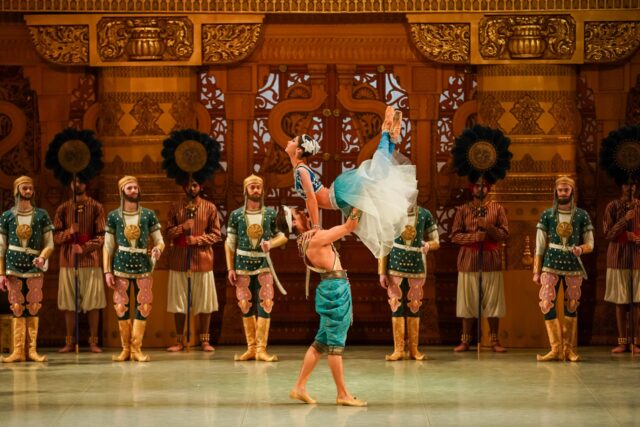
La Bayadère

Libretto by Marius Petipa and Sergei Khudekov
SYNOPSIS
Nikiya, the bayadère, a temple dancer
Dugmanta, Rajah
Gamzatti, his daughter
Solor, the noble warrior
The High Brahmin
Toloragva, a warrior
A Slave
Magdaveya, fakir
Aya, slave
Brahmins, brahmatshors, Rajah servants, warriors, bayadères, fakirs, wanderers, Indian people, musicians and hunters
ACT I
Scene one
A sacred grove with a pagoda. Young noble people are hunting a tiger. The famous warrior Solor specially slows behind the group and calls for the betrayed to him fakir Magdaveya and asks him to tell Nikiya, the bayadère of the pagoda, that he will wait for her at night near the temple. Then he disappears in the grove.
The pagoda’s door opens. The High Brahmin comes, followed by oracles, bayadères, devotees of the temple. The High Brahmin conjures up the sacred fire and gives sign to start the festive. Later he calls for Nikiya, she comes out the pagoda and performs her dance.
In an unguarded moment the High Brahmin passionately declares his love to Nikiya. He promises her patronage and people’s worship but the girl pushes him away with fear.
Striking the right moment Magdaveya reports Solor’s words to the bayadère. She is happy.
At night Nikiya slips outside the temple to the empty square. Solor appears and asks her to run away with him: he is noble and rich, outside the country nobody knows them and nobody would stand in the way to happiness. «Yes, I agree, — says the bayadère, — but you must make an oath that your heart will belong only to me and you will always love me!» Solor makes an oath. The lovers don’t know that the High Brahmin overhears their talk. When they say goodbye he swears to revenge.
Scene two
The Rajah’s palace. Dugmanta declares to his daughter Gamzatti that the time has come for her to become a wife of the bravest of all warriors — Solor. The princess is a little confused: «Will he love me, we don’t know each other?» Dugmanta is relentless: «He is my homage and must fulfill my wish!» — and he commands to call for Solor.
After the Rajah’s words the young man loses his heart. He can’t dare to deny such great honor but what about his oath to Nikiya?..
In celebration of initiation of Gamzatti as a bride the first bayadère was called to the palace — Nikiya. She is followed by the High Brahmin. He gives to understand that he knows the secret and is going to tell it to the Rajah in private. When everybody leaves he tells Dugmanta that he saw Solor and Nikiya at night. So Brahmin wants to get rid of his enemy but the Rajah has his own way: Solor will nevertheless become a husband of the princess and the bayadère must die. The High Brahmin didn’t expect such a decision.
Gamzatti overhears their talk. She orders her slave Aya to bring Nikiya to the palace. The princess shows to the bayadère the portrait of her fiance — and Nikiya recognizes Solor. First Gamzatti begs her to refuse of her love, tries to buy the dancer for jewelry and, finally, demands… But Nikiya would rather die than refuse from her beloved. Desperate, the bayadère suddenly takes a dagger from the table and throws herself at the princess. Aya has had a chance to catch her arm. Nikiya realized what happened and ran away. Gamzatti promises: now there will be no mercy.
ACT II
Scene three
The square of the Rajah’s palace. Everything is ready for the wedding. Solor and Gamzatti perform a marvelous dance but the young man is not happy.
It’s time of the festive dance of Nikiya. She looks at her beloved and all her body weeps with grief. Suddenly somebody brings her a basket of flowers — «from him», pointing at Solor. Nikiya’s mood immediately changes — it means that he still needs her — and she dances vividly and joyfully. But what is this? Suddenly a snake ascends from the basket and stings the bayadère. The High Brahmin gives her treacle but Nikiya, looking at Solor and seeing him lowering eyes, doesn’t accept help. Solor throws himself to her but it’s late.
ACT III
Scene four
Solor is disconsolate. He is full of repentance. Faithful Magdaveya endeavors to distract the young man from crushing thoughts. Listening to sounds of a serpent-charmer flute Solor falls asleep.
Scene five
The space of clouds. Among the Shades.
One by one from darkness emerge the Shades that come forward and make a whole host of light, phantom creatures, twisting and untwisting in various dances.
Nikiya’s shade involves Solor in these dances. He follows her.
Stage Directors
Ballet Master-Producer
Conductor-director
Alyona Pikalova
Production Designer
Costume designer (based on sketches by Evgeny Ponomarev)
Lighting Designer














